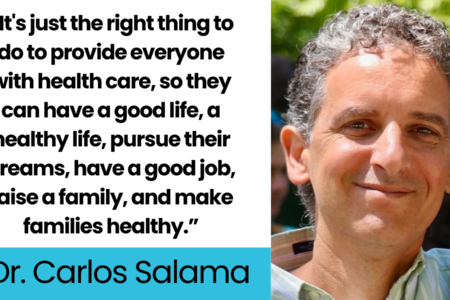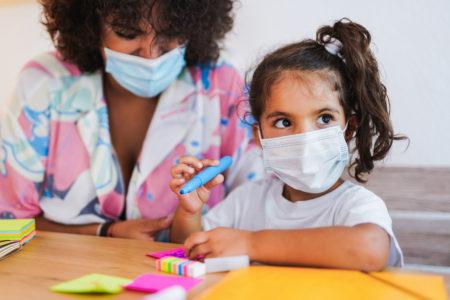
Share On Social!
As COVID-19 cases from the recent Omicron variant surge across the country, health professionals are also detecting a rise in “Flurona,” which is a combination of the common flu and coronavirus.
What really is Flurona and how can you avoid it?
Let’s explore the facts.
What is Flurona?
Technically, Flurona isn’t a new disease.
It occurs when someone contracts both COVID-19 and the flu simultaneously or one after the other.
“Health experts have been warning about the possibility of a ‘twindemic,’ a scenario in which spikes in cases of COVID-19 and a simultaneous rough flu season overwhelm the country’s hospital systems, since early on in the pandemic,” according to Fortune Magazine.
Why is Flurona Happening Now?
Flurona has been happening throughout the pandemic, but the spread of Omicron may be exacerbating it.
“Health experts say the arrival of flurona cases may be attributed to the massive surge in Omicron cases, as the variant currently accounts for 95% of the country’s COVID infections. Omicron’s rapid spread—the nation is averaging more than 585,000 new reported infections daily, a 254% increase compared with two weeks ago—comes during the heart of flu season in the U.S. and abroad,” according to Fortune Magazine.
What Are the Symptoms of Flurona?
The flu has similar symptoms to COVID-19, which can make it difficult to diagnose without getting tested.
“Nasal congestion; coughing; maybe a sore throat; and difficulty breathing or catching your breath, especially with exertion, can be symptoms of the flu, ” said Dr. Stephen McMullan, a Mayo Clinic family medicine physician, according to the Mayo Clinic News Network. “More commonly, what we see are fevers and body aches, specifically muscle aches may be more indicative of the flu itself, rather than other upper respiratory viruses or even COVID-19. ”
The severity of symptoms can vary but are more likely to be mild for those who are vaccinated against COVID-19 and have their flu shots, health experts say.
Can a Booster Shot Help Prevent Flurona?
A COVID-19 booster shot will lessen the chance of COVID-19 infection but doesn’t necessarily eliminate the possibility of Flurona.
“[Booster shots] will help to reduce the number of positive cases, can potentially ease the symptoms if you do become infected with COVID-19, and ultimately will lessen the risk of being hospitalized due to COVID-19 infection,” said Dr. Robert Quigley, the senior vice president and global medical director for International SOS, according to Deseret News.
How Likely Are Latinos to Get Flurona?
Latinos may be susceptible to Flurona due to lower vaccination rates for COVID-19 and the flu.
From 2018-2019, Latinos were 26% less likely than their white peers to have gotten a flu shot.
As of Jan. 12, 2022, about 60% of Latinos have gotten at least one dose of a COVID-19 vaccine, according to KFF Foundation. This number has increased over the last few months but is still lower than the national average of 74.4%.
How is Flurona Treated?
Treatment options are different for COVID-19 and the flu, so they’ll need to be treated as two separate viruses.
“The treatment options in use for COVID-19 at medical facilities include oxygen, corticosteroids and IL6 receptor blockers for severely ill patients, and in other severe cases, the use of respirators. Antiviral drugs for influenza can reduce severe complications and death, and they are especially important for high-risk groups,” according to Silive.
If symptoms are mild, it can be treated at home with isolation, rest, and other traditional treatment methods.
How Can I Avoid Flurona?
The best way to avoid Flurona is by getting fully vaccinated and boosted against COVID-19 as well as an annual flu shot.
“Continue to do the same strategies to protect yourself and others, such as wearing a mask in high-risk situations, washing your hands and staying home if you feel ill,” said Dr. McMullen, according to the Mayo Clinic News Network.
How Can Latinos Stop the Spread of COVID-19 and the Flu?
You can also make sure to continue practicing safety precautions, no matter your vaccination status. The CDC recommends that everyone continue to wear masks in indoor public places.
Other recommendations include social distancing, avoiding crowds, getting tested before and after social gatherings, washing hands, and more.
Parents can learn more about the vaccine for children ages 5 to 11 and children 12 and up.
Stay informed by learning the facts about COVID-19 and the vaccine and avoiding vaccine misinformation, which is prominent and often targets Latinos.
One resource you can use is Salud America!’s Latino COVID-19 Vaccine “Change of Heart” Bilingual Storytelling Campaign. The campaign, also in Spanish, shares the stories of real Latinos who overcame misinformation, got the vaccine, reconnected with family, and are helping end the pandemic.
Helen Cordova is one of the Latinas who was unsure about the vaccine initially. She was nervous it was produced too quickly and that it wouldn’t be safe.
But after learning more about the vaccine, she decided to get it so she could protect her family and her patients in the ICU. She became the first person in California to get vaccinated!
You can share Helen’s story with your friends, family, and colleagues!
By The Numbers
142
Percent
Expected rise in Latino cancer cases in coming years




[…] The pandemic is another chapter in the bitter story of American racism and inequality. Black and Latinx people are being infected and are dying at much higher rates than white Americans. Many people of […]
[…] coronavirus has killed over 61,000 Latinos in America according to the CDC, accounting for over 18.2% of the total COVID deaths in the […]
[…] Whereas Hispanics make up 11% of D.C.’s inhabitants, they signify 19% of the COVID cases, and 14% of the deaths. Equally, 46% of D.C.’s residents are Black, they usually make up an alarming 75% […]
[…] and historical mistreatment. According to the U.S. Centers for Disease Control and Prevention, Latino and Black American communities are three times more likely to become infected with […]
[…] Covid pandemic has hit the Latino community particularly hard, and data from the nonprofit health equity advocacy group Salud America! shows Latinos lead in the 0-24 age […]
[…] the pandemic, Latinos took major blows, both in terms of COVID-19 cases and also from the economic recession under former President Donald Trump. Nearly half (49%) of […]
[…] the positive trend, the harm may have already been done. The pandemic has disproportionately impacted Latino communities. Reuters reported that election-related or political disinformation that […]
[…] pesar de la tendencia positiva, es posible que el daño ya esté hecho. La pandemia ha impactado desproporcionadamente Comunidades latinas. Reuters informó que la desinformación política o relacionada con las […]
[…] residentes blancos muestran una tasa mucho más baja con 10 muertes por cada 100,000 habitantes(8 9) . Los afroestadounidenses por su parte, denuncian subsistemas de salud que les segregan […]
[…] https://salud-america.org/coronavirus-case-rates-and-death-rates-for-latinos-in-the-united-states/ […]
[…] https://salud-america.org/coronavirus-case-rates-and-death-rates-for-latinos-in-the-united-states/ […]
[…] communities have the second-highest number of COVID-19 cases in the U.S. They’re also more likely to become hospitalized and die from the disease than other […]
[…] total, around 160,000 Latinos were killed by COVID-19. This accounts for 16% of the 1 million deaths in the country. The […]